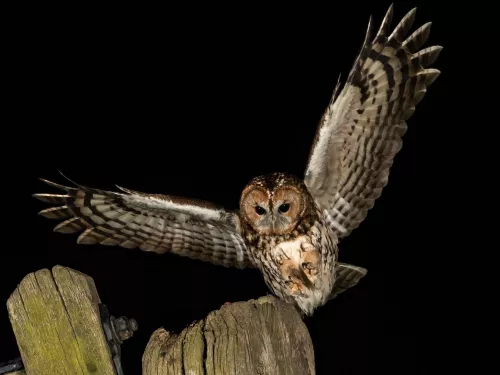Tansy
Tansy is an aromatic plant of rough grassland, riverbanks and verges that has button-like, yellow flower heads. It is the main foodplant of the rare Tansy Beetle, now found at only two places in the UK.
Tansy is an aromatic plant of rough grassland, riverbanks and verges that has button-like, yellow flower heads. It is the main foodplant of the rare Tansy Beetle, now found at only two places in the UK.
This jewel like leaf beetle is an incredibly scarce species which is only found in wetland habitats.
The tawny grisette has an orange-brown cap and a tall, slender stem that arises from a conspicuous cup-like sack. It can be found in woodlands, particularly those with Birch, but also on heaths.
The Tawny mining bee is a furry, gingery bee that can often be seen in parks and gardens during the springtime. Look for a volcano-like mound of earth in the lawn that marks the entrance to its burrow.

Tawny owls are the familiar brown owls of Britain’s woodlands, parks and gardens. They are known for their ‘too-wit too-woo’ song that can be heard at night-time.
The teal is a pretty, little dabbling duck, which can be easily spotted in winter on reservoirs, gravel pits, and flooded meadows. Watching flocks of this bird wheel through a winter sky is a true delight.
The brown, oval, spiky seed heads of the teasel are a familiar sight in all kinds of habitats, from grassland to waste ground. They are visited by goldfinches and other birds, so make good garden plants.
A handsome fish, the tench has olive-green flanks, powerful fins and distinctive red eyes. It can be found in lowland lakes and slow-flowing rivers around the UK.
The thick topshell is a common sight on rocky shores in Wales and South West England.
Their empty, delicate pink or yellow shells can often be found washed up on beaches, but the animals themselves live buried in the sand all around the coasts of the UK.
The most commonly encountered ray around the British Isles, it's easy to see where the thornback ray got its name from - just check out the spines on its back!
A diminutive but aggressive predator, the three-spined stickleback hunts tadpoles and small fish. It is also known for fiercely protecting its nest of eggs until they hatch. Look for it in ponds, lakes and rivers.